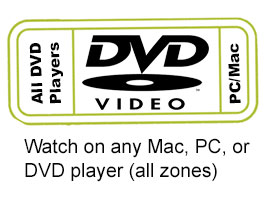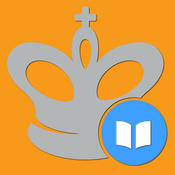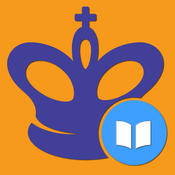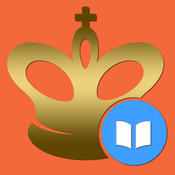Chess King 2019 Buyer’s Guide
Chess King’s Software Guide on How to Improve at Chess in the 21st Century
By GM Alexandra Kosteniuk
 Since I started playing chess at age 5 until I became Women Grandmaster at age 14, Men Grandmaster at age 20, and the 12th women’s world chess champion at age 24, I have gone through all the levels from beginner to Grandmaster. My current rating is 2550 ELO, I’m the top woman in Russia, and the 4th in the world.
Since I started playing chess at age 5 until I became Women Grandmaster at age 14, Men Grandmaster at age 20, and the 12th women’s world chess champion at age 24, I have gone through all the levels from beginner to Grandmaster. My current rating is 2550 ELO, I’m the top woman in Russia, and the 4th in the world.
In this article, I’d like to give you some ideas on how to improve at chess, and how new technology can help in this 21st century. I give advice for each level on what best way you can train to improve to get to the next level using any one of these modern methods: Chess software, Video DVD’s, Interactive CD’s, Android or iOS apps, and web-based Training.
Our newest and most convenient way to improve at chess is with our Chess King Learn offerings, on the web and on mobile. Specials and combos can be found in our shop.
Don’t hesitate to email me or Diego if you have any questions.
By 12th Women’s World Chess Champion and Grandmaster Alexandra Kosteniuk
First Test yourself or Estimate your Current Rating
You might have an idea of your current rating, from an online playing site like ours www.chessking.com for example.Improvement Guide Articles
Here are some articles by GM Alexandra Kosteniuk and chess guru Steve Lopez on how best to improve at chess from different levels. You can come back to this main page anytime.The Official Chess King Level Table
Knowledge required to Graduate to the next level
Level 0: Introduction. Unrated.
 How pieces move and capture. The concepts of mate, check and stalemate. The initial position, castling, capturing en passant and pawn promotion. Board geometry. Value of pieces.
How pieces move and capture. The concepts of mate, check and stalemate. The initial position, castling, capturing en passant and pawn promotion. Board geometry. Value of pieces.
Level 1: Beginner. Rating 200 – 600.
 Mating in 1 move in positions with few pieces on the board. Finding unprotected pieces and picking best captures. Mating a bare king with two major pieces. Chess notation. Scholar’s mate and how to counter it.
Mating in 1 move in positions with few pieces on the board. Finding unprotected pieces and picking best captures. Mating a bare king with two major pieces. Chess notation. Scholar’s mate and how to counter it.
Level 2. Rating: 600 – 1000
 Mating in 1 move in positions with many pieces on the board. Mating with king and queen or rook. Spotting and defending unprotected pieces. The rule of the square and what it means in the endgame. Double attack, fork, pin. Basic opening principles (piece development).
Mating in 1 move in positions with many pieces on the board. Mating with king and queen or rook. Spotting and defending unprotected pieces. The rule of the square and what it means in the endgame. Double attack, fork, pin. Basic opening principles (piece development).
Level 3. Rating: 1000 – 1200.
 Spotting simple opportunities to use the motifs: discovered check, undermining. Spotting and protecting pieces in danger. Defending against mate in 1 move. Basic principles of chess endings king+pawn vs king. Passed pawns. The names and first moves of some openings.
Spotting simple opportunities to use the motifs: discovered check, undermining. Spotting and protecting pieces in danger. Defending against mate in 1 move. Basic principles of chess endings king+pawn vs king. Passed pawns. The names and first moves of some openings.
Level 4. Rating: 1200 – 1400.
 Finding simple decoy, deflection and interference combinations. Finding forced mates in 2 moves. Main principles of playing rook+pawn vs rook. Occupying open lines. The center. The names and first moves of all main openings.
Finding simple decoy, deflection and interference combinations. Finding forced mates in 2 moves. Main principles of playing rook+pawn vs rook. Occupying open lines. The center. The names and first moves of all main openings.
Level 5. Rating: 1400 – 1600.
 Finding medium difficulty decoy, distraction and interference combinations.
Spotting and calculating complex mates in 2 moves. Defending against mate and other threats. “Good” and “bad” pieces. Favorable and unfavorable exchange. Strong and weak squares. Aims and basic theory of common openings. Basic principles of pawn and rook endings (opposition, rook behind passed pawns etc)
Finding medium difficulty decoy, distraction and interference combinations.
Spotting and calculating complex mates in 2 moves. Defending against mate and other threats. “Good” and “bad” pieces. Favorable and unfavorable exchange. Strong and weak squares. Aims and basic theory of common openings. Basic principles of pawn and rook endings (opposition, rook behind passed pawns etc)
Level 6. Rating: 1600 – 1800
 Complex combinations on decoy deflection, interference, undermining. Spotting forced mates in 3-4 moves. Endings with same-squared or different-squared bishops. Key positions in rook, bishop and pawn endings. Typical pawn structures: isolated and dangling pawns, their advantages and disadvantages. Typical maneuvers. Solid knowledge of all main lines in chosen openings.
Complex combinations on decoy deflection, interference, undermining. Spotting forced mates in 3-4 moves. Endings with same-squared or different-squared bishops. Key positions in rook, bishop and pawn endings. Typical pawn structures: isolated and dangling pawns, their advantages and disadvantages. Typical maneuvers. Solid knowledge of all main lines in chosen openings.
Level 7. Rating: 1800 – 2000
 Spotting and devising multi-move combinations. Main strategy principles and maneuvers. Advanced knowledge of opening and endgame maneuvers. Base skills used in middlegame. Analyzing piece positions to evaluate the situation on the board and devise simple plans. Knowing typical combinations and plans in played openings.
Spotting and devising multi-move combinations. Main strategy principles and maneuvers. Advanced knowledge of opening and endgame maneuvers. Base skills used in middlegame. Analyzing piece positions to evaluate the situation on the board and devise simple plans. Knowing typical combinations and plans in played openings.
Level 8. Rating: 2000 – 2200
 Solid understanding of middlegame and typical combinations in various openings. Discerning the opponent’s plans and building counterplans.
Preventive measures and maneuvering in different stages of play.
Solid understanding of middlegame and typical combinations in various openings. Discerning the opponent’s plans and building counterplans.
Preventive measures and maneuvering in different stages of play.
Level 9. Rating: 2200 – 2400+
 Deep understanding of all stages of play. Modern trends in opening theory.
Employing dynamic and static positional factors when devising a plan. Mastery in all endings.
Deep understanding of all stages of play. Modern trends in opening theory.
Employing dynamic and static positional factors when devising a plan. Mastery in all endings.
Chess King improvement guide (introduction)
The question is as old as the Royal Game itself: “How do I improve at chess?”Everyone asks this question at some point in their chess playing career. Beginners naturally ask the question, as the game of chess contains a bewildering array of pieces (each with their own moves) and an astronomical number of possibilities for moving them once the game has begun. Club players sometimes find themselves “plateauing” at a particular skill level or rating, a point at which they feel that their improvement has stalled, perhaps permanently. Even professional players can feel this inertia, unhappy with their apparent lack of progress toward becoming a better player. It’s a natural question for players of every level to ask, but it’s a difficult one to answer.
“How do I improve at chess?”
The answer will vary from player to player, but it’s primarily dependent on one’s individual level of experience and expertise. While the exact solution for one player will differ from that of another, it is possible to make some broad suggestions based on a player’s rating and skill level. That’s the purpose of this guide: to offer you some general suggestions for improvement based on your skill level, recommend some specific training materials which will help speed the progress of your improvement, and show you how to use these training materials in an effective manner.
To understand how we learn to be better chessplayers, we first need to understand how we learn any skill. We’re going to borrow some information from The Ultimate Guide to Chess King by chess author Steve Lopez (available as a free download from chessking.com). In that guide, the author describes the learning process as a circle in which students cycle between studying, practicing, and analyzing. Stated briefly, we’re exposed to new skills and concepts by studying them, after which we put our knowledge to practical use, and then we analyze and evaluate how well we utilized the information. We then return to the study stage, either to reinforce the acquired knowledge or, if we’ve used it successfully, to acquire new knowledge that we’ll put into practice.
For example, you might study the basics of King and pawn endings. Then, when you play a few games, you’d be able to put this knowledge to use (either in the late middlegame, when evaluating whether or not trading pieces to reach an endgame would be beneficial, or in an actual endgame in which Kings and pawns are the only material remaining on the board). After these games you would analyze the results (perhaps with the assistance of a chess playing engine, such as Chess King’s Houdini) to see how well you used your knowledge of King and pawn endgames. Then you’d either study the material on King and pawn endings again (if you’d done poorly), move on to more advanced principles of King and pawn endings, or (if you’re comfortable with your knowledge and performance) study a different endgame concept entirely (perhaps Queen or Rook endings).
This learning cycle is infinite; it literally never ends. No matter how accomplished you become at chess (or any other discipline), there is always more to learn. The trick is to use your study time effectively. Chess software can often help you make the most of your limited study time. And there is a free chess program you can use as an interface to access many kinds of chess training materials which will help you with the study and practice parts of the learning cycle. The program is called Peshka, and we’ll learn more about it in the next section of our guide.
Chess Software Tools to improve at Chess
Playing and Analysis and Database Chess Software
 Depending on whether you would like ease of use or more database management capabilities, go for Chess King or Chess Assistant. Chess Assistant is Windows only. Chess King comes in PC and Mac versions.
Depending on whether you would like ease of use or more database management capabilities, go for Chess King or Chess Assistant. Chess Assistant is Windows only. Chess King comes in PC and Mac versions.


Peshka Interactive Software
 Mating in 1 move in positions with few pieces on the board. Finding unprotected pieces and picking best captures. Mating a bare king with two major pieces. Chess notation. Scholar’s mate and how to counter it.
Mating in 1 move in positions with few pieces on the board. Finding unprotected pieces and picking best captures. Mating a bare king with two major pieces. Chess notation. Scholar’s mate and how to counter it.
Video DVD Instructions
 It would be a good review to watch the Complete Chess Course 3 DVD combo and the Chess Opening Ideas video DVD’s.
It would be a good review to watch the Complete Chess Course 3 DVD combo and the Chess Opening Ideas video DVD’s.
Android Software
 Check out our Chess King Android Apps on the Play Store.
Check out our Chess King Android Apps on the Play Store.We have more than 20 Android Chess apps and more come out every week. Already more than 1 million downloads. All courses are free downloads and provide sample theory and exercises. If you like the course, you can buy the full course.
iOS (iPhone/iPad) Software

Chess: From Beginners to Club (200-1600)
This teaching program is a kind of guide. It will introduce you to the rules and laws of chess and let you work your way of improvement from the level of Beginner to the one of Club Player.
In the course 100 chess topics are considered including rules of chess game; methods of playing in opening, middle game and ending; combinational techniques and basic elements of strategy. All in all, the course contains 500 teaching examples and 700 exercises useful for consolidation of acquired knowledge.
Mate in 1 move (Chess Puzzles)

If you are a beginner, you should practice much to mate in one move. This course provides excellent material for this training. The big number of exercises (2500) covers different methods of mating. Many of them is an excellent tool for speed training even for stronger players. This is a rare course that is intended even for players with USCF rating of 600. Even if you only study and solve 10% of the exercises, you will learn a huge number of mating patterns and probably never miss a mate in one again!
Chess Strategy for Beginners

This course is an interactive tutorial for those unexperienced players, both children and adults, who have already learnt the rules of chess and now wish to become players of intermediate strength.
This course covers a wide range of opening, middlegame and endgame subjects. It starts off by teaching you how to checkmate the lone king and proceeds to more advanced topics, such as utilizing a material or positional advantage. This program includes 55 lessons with more than 1200 instructive examples and exercises.
This course turns a beginner into an intermediate player!
Chess Tactics Art (1600-1800)

A fundamental course on chess tactics for Club Players. The course contains 240 teaching examples and 340 new exercises useful for consolidation of acquired knowledge. The exercises are classified according to about 30 tactical methods and motifs.
This course is in the series Chess King Learn, which is an unprecedented chess teaching method. In the series are included courses in tactics, strategy, openings, middle game, and endgame, split by levels from beginners to experienced players, and even professional players.
Chess Tactics Art (1400-1600)

A fundamental course on chess tactics for Beginners. The course contains 150 teaching examples and 1500 new exercises useful for consolidation of acquired knowledge. The exercises are classified according to more than 30 tactical methods and motifs.
Mate in 3-4 (Chess Puzzles)

This course includes more than 2500 exercises for mating in 3 or 4 moves. You will have to use your fantasy and precise calculation in order to find a correct way of attacking the king. After going through this course you are sure to improve your skills and abilities considerably and will not miss an opportunity to employ a nice little combination in a practical game of your own. The program is intended both for club players and intermediate players. All the exercises are taken from practical games and arranged according to the names of pieces and difficulty levels.
CT-ART. Mating Combinations

CT-ART. Mating Combinations program is the unique due to two causes: the high quality of the theoretical material and a new technology of giving the studying material, the iBook technology that uses hyperlinks and additional windows for comfortable usage of the studying material. The course is prepared by the famous coach Victor Khenkin.
Chess Tactics in Sicilian Defence

This course is aimed at club and intermediate players and presents the theory and playing hooks in the most sharp and deciding variations of the Sicilian Defense developing after moves 1. e4 c5 2. Nf3 Nc6: the Lasker variation, the Paulsen variation, the Labourdonnais variation, the Simagin variation and the Boleslavsky defense.
Chess Tactics in French Defense

This course is aimed at club and intermediate players and presents the theory and playing hooks in the most sharp and deciding variations of the French Defense developing after moves 1.e4 e6.
The course presents a deep theoretical and practical overview of the actual variations, featuring about 130 examples and about 330 exercises to solve. The course will be useful to all chess players employing the French Defense on either white or black sides.
Chess Tactics in Caro-Kann Defence

This course is aimed at club and intermediate players and presents the theory and playing hooks in the most sharp and deciding variations of the Caro-Kann Defense developing after moves 1.e4 c6.
The course presents a deep theoretical and practical overview of the actual variations, featuring about 150 examples and about 350 exercises to solve. The course will be useful to all chess players employing the Caro-Kann Defense on either white or black sides.
Chess Endgame: Beginners-Club

Total Chess Ending course composed by GM Alexander Panchenko. It’s aim is to teach a student the intricacies of the endgame through a theoretical section, which includes over 600 games/lectures, each of them illustrating theoretical and practical endgame methods, and training section, with more than 2400 endgame exercises, classified according to 500 endgame themes. The material written by IM ICCF Alexander Alpert.
Chess World Champions. Bobby Fischer’s Best Games
All 946 games played by the legendary World Champion, 217 of them with commentary. 180 exercises: play like Fischer and play against Fischer.
Chess Middlegame III

Chess Middlegame III course composed by GM Alexander Kalinin is aimed at teaching a student much of the middlegame methods and intricacies through a theoretical section. Openings: Sicilian defense (Closed System and 3. Bb5 var.), Scandinavian defense, Grunfeld defense, Queen’s Gambit Accepted, Reti opening and others.
Chess Middlegame IV

Chess Middlegame IV course composed by GM Alexander Kalinin is aimed at teaching a student much of the middlegame methods and intricacies through a theoretical section. Openings: Two Knights’ defense, Sicilian defense (Richter-Rauzer attack), French defense (3. e5 and 3. Nc3 Nf6 4. Bg5 variations), Caro-Kann defense (3.e5 var.), English defense etc.
Chess Middlegame V

Chess Middlegame V course composed by GM Alexander Kalinin is aimed at teaching a student much of the middlegame methods and intricacies through a theoretical section which includes over 500 games/lectures each of them illustrating typical plans and methods in the following openings: Petroff defense, Ruy Lopez, Sicilian defense, Queen’s Gambit, and etc. More than 400 exercises for a user to solve, giving refutations of the wrong moves as well as numerous hints to help you find the correct answer.
Chess Combinations Vol. 1

The fundamental chess program for club players. This first part includes more than 1300 exercises (more than 200 examples to explore and 1100 to solve), classified in 40 tactical methods and motifs.
Chess Combinations Vol. 2

The fundamental chess program for club players. This second part includes more than 2600 exercises (more than 400 examples to explore and 2200 to solve), classified in 60 tactical methods and motifs.
Chess King Learn web-based instruction
 For a limited time all Chess King Learn web-based Courses are free!
For a limited time all Chess King Learn web-based Courses are free!Check out our courses. We are adding more every week. Select the language you want and the course.
You can substitute any Peshka program for another of the same or inferior value. Email us for info to chesskingtraining@me.com































